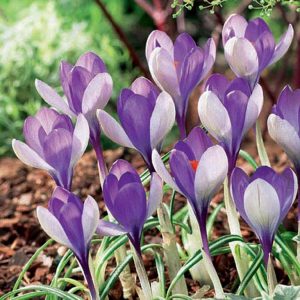Just like Dealing?
I know that autumn is looming. The French partridges have started sunning themselves on my low stone walls and they’re so tame and plump, having been reared in cages for dare I say the shooting season, that they only fly off when I’m feet away. They’re the Liz Taylors of the game birds, with exotic eye make up worthy of Cleopatra herself. On the weather front there are misty mornings with heavy dew and cool evenings when I long for the log burner and underfloor heating. But no! It’s only August the Best Beloved cries, so I’m waiting until September before I toast my toes.
I’ve been on the trail of bulbs this month, exchanging large amounts of money for small packets of treasures that include miniature narcissi, snowdrops and erythroniums. The Best Beloved says it’s just like dealing, although the only thing he’s ever bought in small packets is dolly mixtures. It’s the same for me by the way!
We’ve just been to a bulb sale in East Anglia and it was held in the splendid garden of an old mill house on the Suffolk/ Essex border. The Best Beloved spent £4.00 on two packets of species tulips ( from Riverside Bulbs – www.riversidebulbs.co.uk ) and then went botanising for three hours clocking up some ‘rarish’ water plants and seeing a kingfisher. After that he admired the garden which was productive and pretty.
I was completely blinkered and only saw small plastic packets, each with one expensive bulb packed in vermiculite. I raided the housekeeping before we went and wrote a cheque for my treasures as well, so my guilt levels are running high. Worse still, I’m furtive. I lurk close to famous bulb growers to see what they have bought, for if it’s good enough for them it must be good enough for me. It seems I’m still caught up in the wonder of bulbs, although the Best Beloved calls it an obsession and mentions the word kleptomania. Despite all that, these small brown things that flower next spring still seem magical to me.
Now I’ve got back I’ve recorded my treasures under the heading of ‘naughty acquisitions’ for I never used to buy dormant snowdrops bulbs in August. However the dormant snowdrop lists have become more and more tempting year by year. This year Avon Bulbs ( www.avonbulbs.co.uk ) have a great list and I was able to acquire one of my holy grails in the shape of ‘The Alburgh Claw’, a spiky snowdrop of much larger size than most. It sold out quickly because it’s so rarely for sale. That alone tells you something. It’s almost certainly miffy and difficult to grow, like many of the spikies.
‘Spikies’ are aberrant snowdrops which have lots of strappy petals rather than the three outers and inners. ‘Boyd’s Double’, the oldest of them all, was known to E.A. Bowles, a famous galanthophile who lived at Myddelton House near Enfield. He painted this in 1910, having acquired it from Sir Henry Boyd I believe. Bowles loved anything quirky and unusual and you can still visit his garden today for nothing and see his Lunatic Asylum, where he planted all these oddities( www.visitleevalley.org.uk/en/content/cms/nature/…/myddelton-house-gardens).
None of the ‘spikies’ are easy to grow and, if you do succeed, they are shy to flower. I have lost ‘Boyd’s Double’, although it never flowered for me anyway and I am not alone. I have succeeded with ‘Mrs Tiggiwinkle’, after five years of her making up her mind, and ‘Irish Green’. So I wanted to try ‘The Alburgh Claw’ a snowdrop discovered in 1993 by Robert Marshall in Alburgh in Suffolk. It know it will be a challenge, but spikies flower later than almost anything else so they are good additions. Or that’s what I tell the Best Beloved – although I never disclose or record the prices.

I’ve also ordered some crocuses and this is tempting fate because one of them is the delightful ‘Yalta’. This purple and silver creation, with a large orange feather duster in the middle, attracts the voles and they leave little empty holes where it should be. ‘Yalta’, which is now widely grown in Holland so very available, was originally grown from seed sown by the Latvian bulb specialist Janis Ruksans, author of “Buried Treasure” published by Timber Press. He obtained seeds of C. tommasinianus from Nikitskyi Botanical Gardens in Yalta in the Crimea. One plant was clearly different from the rest and had almost certainly hybridised with a large Dutch crocus, probably ‘Vanguard’.
‘Vanguard’ is a fine crocus with large silver-grey and purple flowers, originally collected in Russia in 1934. Bowles writing in his “Handbook of Crocus and Colchicum”, published in 1924, admires it because “it flowers much earlier” than other Dutch crocuses – hence its name of ‘Vanguard’. It used to be called ‘Petropolowski’, a less seductive name. The voles are less keen on this than ‘Yalta’ and I grow the two close together.
‘Vanguard’ used to be unavailable and then about ten years ago I spotted it in a bulb catalogue and ordered it. Then I saw it another catalogue and another and soon I had ordered 200 or so. I never thought any of these orders would come to fruition, but they did and I was overwhelmed with them and able to give some away. Now ‘Yalta’ and ‘Vanguard’ can be bought widely and they’e both lovely purple and almost silver-petalled crocuses.
On the tulip front I’m filling my oak half barrels with pink, white and sultry tulips. And this year I will make sure that they are planted in John Innes loam-based compost rather than wood-based compost which they hated. ‘Pink Diamond’ and ‘Paul Scherer’, a dark violet-black, will rub shoulders with white tulips such as the fringed ‘Daytona’.
Tulips are best planted late and these days, now that autumn seems to stretch on for ever, early November is usually the appointed time. I’m looking forward to them already. It’s no wonder that gardeners are the enthusiasts of the planet!



